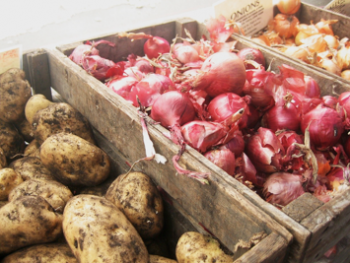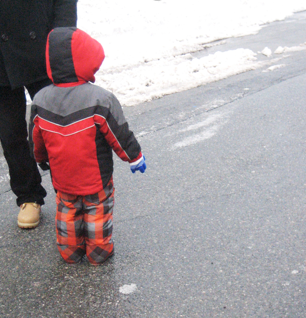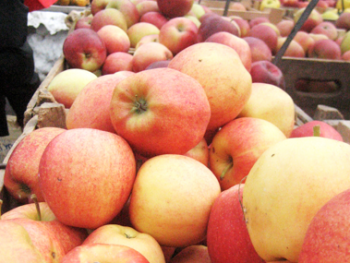Meet Your Vegetables: The Farmers Market in Winter
by Jaime Green

By this time of year, the Inwood farmers market is a slim affair. Never particularly expansive even in the summer, the shoppers and sellers have dwindled. There is a trickle of, I don’t know, either hardcore locavores or devotees of the greenmarket social scene, the urban hippie parents catching up on neighborhood gossip and scheduling playdates. There is local wine and local seafood and apple turnovers the size of your face. I don’t know if those are made with local flour, and I’ve always worried it would be an asshole move to ask.
This market takes up both sides of a block at the edge of a park that’s at the edge of Manhattan. Beyond the market you can see the Henry Hudson Bridge over the waters of Spuyten Duyvil, the creek that makes Manhattan an island. Closer there are tennis courts and woods between you, standing in the farmers market, and the Bronx, across the little creek.
In summer the place is mobbed by the neighborhood’s weird mix-young Dominican mothers and abuelas, middle-aged white ladies with toddlers and no make-up and skirts woven by lady artisans in Palestine, off-Broadway actors with cute boyfriends and large dogs. There’s the fishmonger (if mongering is something you can do at a stall with a plastic tarp roof), the winery, the honey farm, the bakery and then the organic bakery, which also boasts biodynamic produce. (I’m under the impression that biodynamic farming is an offshoot of homeopathy, and so a bullshit idea by association? They have good brownies there, though.)
Then, in winter, once the autumn leeks and kale run out, it’s potatoes, mushrooms, and three kinds of onions, and winter squash that might be a little past its prime. The cellared apples are cheaper than they were in the fall, but just as good, all fifteen or howevermany varieties. Eggs are four dollars a dozen, which is probably worth the farmer’s promise, which you probably believe, that the chickens that laid them are happy hens, eating grass and bugs in the sunshine. Maybe a little hay and corn now, on the far side of winter.
But still, for this and those apple turnovers, the market’s not empty, and there’s enough produce to make it feel worthwhile, as long as you don’t need your vegetables to be green.

There was also this little kid wearing really awesome pants.
Last week, Marion Nestle and David Ludwig wrote an op-ed for JAMA [pdf] calling for the abolition of front label claims on foods. No “boosts your child’s immunity!” on a box of enriched Frosted Flakes, just ingredients and the familiar panel of nutrition “facts.” (Those scare quotes make me feel like a birther conspiracy theorist but about trans fats. Although, speaking of, did you know that foods can have just under half a gram of trans fats in a serving and be able to proclaim, “trans-fat free!” Then, if you eat two or three servings, you die.)
The European Food Safety Authority just handed down a bunch of decisions on food marketers’ petitions, citing lack of information and proof, and general vagueness even identifying the substances on which the claims would be made. (Do you know what a probiotic is? Do you know what it is that has to be added to yogurt, that isn’t in yogurt already?) They rejected claims for vitamin D, probiotics, green tea, black tea, lutein, beta glucans, meso-zeaxanthin, alpha-lipoic acid, melatonin, peptides, xanthan gum, sugar-free gum, guar gum, gamma-linolenic acid (GLA), fermented whey and linoleic acid.
“Now with meso-zeaxanthin! It does something!”
(I checked, and it’s supposed to be good for your eyes.)
(Eat a fucking carrot.)
It used to be that margarine (once the savior of the heart disease/saturated fat-phobic, now a trans fat pariah, because we really have no idea what we’re doing) had to be dyed pink because it was not allowed to masquerade as real butter. Now we’re at me asking my mom why she still buys that insanely expensive probiotic yogurt when it’s not actually making her feel any better. (She shrugs and deflects, and I feel bad for asking.)
In 1906 the Pure Food and Drug Act prohibited food labels from carrying claims that were “false or misleading in any particular,” and for decades the FDA’s interpretation put just about all nutrition claims under that umbrella. The olden days FDA opposed even the fortification of some foods with nutrients so that, say, a chocolate bar couldn’t boast its high content of iron or vitamin C.
In 1990 Congress passed the Nutrition Labeling and Education Act, which instructed the FDA to allow food labels to bear “scientifically substantiated” health claims. (Scare quotes, direct quote, or both?) 1994’s Dietary Supplement Health and Education Act permitted supplement labels to advertise support for structures or functions of the body, and the food industry demanded similar permission. It’s safely taken for granted, at this point, that whatever the food industry demanded, they got.

The apples I take home from the greenmarket don’t have front or back labels, just a magic marker sign over their crate telling me the variety and the price. (Last year there also would’ve been a “Don’t fear the pockmarks!” sign explaining that early summer hail had scarred the baby apples as they grew. They didn’t come with nutrition facts but they sure told me about the weather outside Ithaca six months before.)
Heading down the hill to the supermarket where I will guiltily buy a bunch of nonlocal C-Town Swiss chard, because I have need for vegetables that are actually green and acorn squash doesn’t count, I leave behind neighbors stocking up on local bison sausage and scallops or whatever. Apple turnovers, sauerkraut and jam. In the winter the Dominican families are all but gone; it’s just the gentrifying families who like living near the parks and the gentrifying kids who can’t afford real one-bedrooms anywhere else. (We also like the parks, when we discover them a year after moving here.)
Half-way between my apartment and the market is a big empty lot. The only way it’s changed in the three years I’ve lived here is a cyclical sprouting and withering of its weeds, I think in rhythm with the applications of RAT POISON (CAUTION!) announced on signs on the fence. When I walk by with my little canvas bag of my little local vegetables with their local bits of local dirt still clinging on, I always wish the space were a community garden. I don’t know if the RAT POISON irrevocably poisons the ground, but also I’ve never done the three or so Google searches it’d take to see how people transform empty lots into gardens. I’m sure there are people or organizations who do this sort of thing, I wouldn’t even have to figure it out. I imagine my plot adjacent to that of a young Dominican mother, her fat baby babbling Spanish in the sun as we tend our plants. We’ll coax food from dirt and light and water, sweet summer tomatoes and cilantro at least. (I had a pot of herbs two summers ago that I killed for lack of light.)
This week the lot’s covered in the most pristine snow left in the city, though someone’s crept through a snag in the fencing to stamp their footprints around. In the summer I’ll sometimes see a stray cat strolling through the weedy shoots, and it’ll stop and eye me before moving on through the grass. I don’t know if the RAT POISON signs are empty threats, or what.
Jaime Green definitely does not ever get Cheetos from the vending machine at work.
